TOYOTA C-HR 2023 Owners Manual
Manufacturer: TOYOTA, Model Year: 2023, Model line: C-HR, Model: TOYOTA C-HR 2023Pages: 814, PDF Size: 112.62 MB
Page 91 of 814
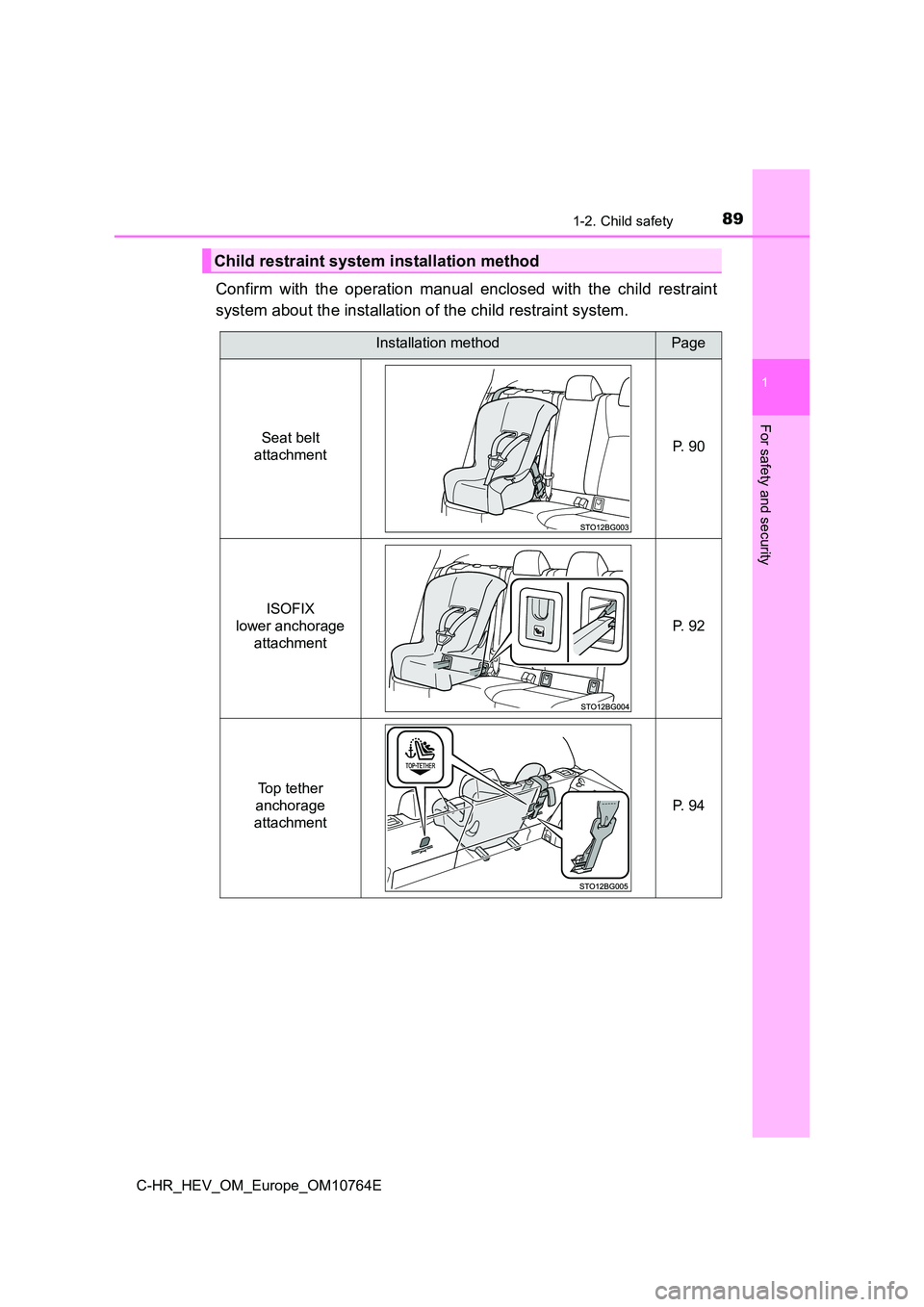
891-2. Child safety
1
For safety and security
C-HR_HEV_OM_Europe_OM10764E
Confirm with the operation manual enclosed with the child restraint
system about the installation of the child restraint system.
Child restraint system installation method
Installation methodPage
Seat belt
attachment P. 90
ISOFIX
lower anchorage
attachment
P. 92
Top tether
anchorage
attachment
P. 94
Page 92 of 814
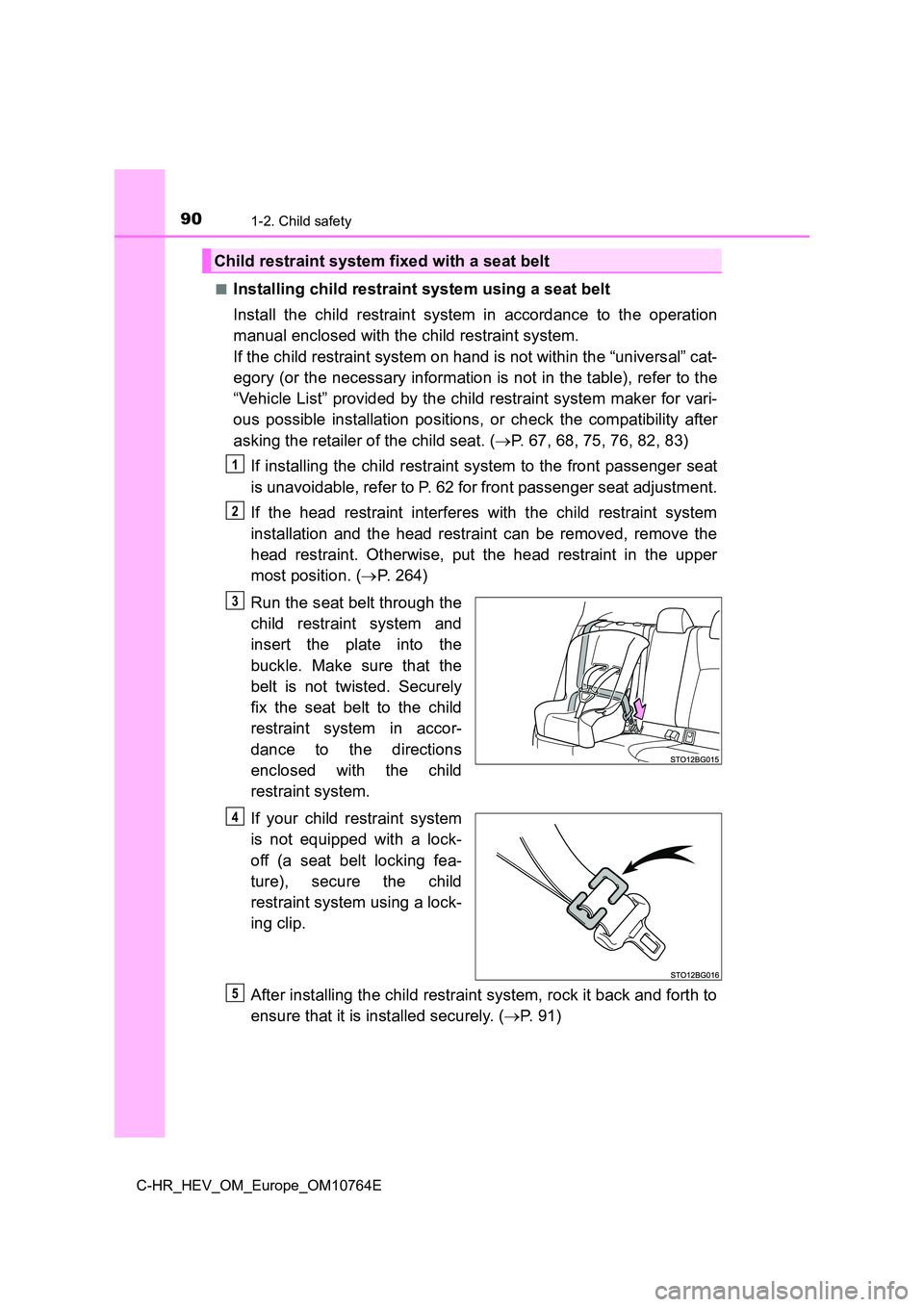
901-2. Child safety
C-HR_HEV_OM_Europe_OM10764E
■Installing child restraint system using a seat belt
Install the child restraint system in accordance to the operati on
manual enclosed with the child restraint system.
If the child restraint system on hand is not within the “univer sal” cat-
egory (or the necessary information is not in the table), refer to the
“Vehicle List” provided by the child restraint system maker for vari-
ous possible installation positions, or check the compatibility after
asking the retailer of the child seat. ( P. 67, 68, 75, 76, 82, 83)
If installing the child restraint system to the front passenger seat
is unavoidable, refer to P. 62 for front passenger seat adjustm ent.
If the head restraint interferes with the child restraint syste m
installation and the head restraint can be removed, remove the
head restraint. Otherwise, put the head restraint in the upper
most position. ( P. 264)
Run the seat belt through the
child restraint system and
insert the plate into the
buckle. Make sure that the
belt is not twisted. Securely
fix the seat belt to the child
restraint system in accor-
dance to the directions
enclosed with the child
restraint system.
If your child restraint system
is not equipped with a lock-
off (a seat belt locking fea-
ture), secure the child
restraint system using a lock-
ing clip.
After installing the child restraint system, rock it back and f orth to
ensure that it is installed securely. ( P. 9 1 )
Child restraint system fixed with a seat belt
1
2
3
4
5
Page 93 of 814
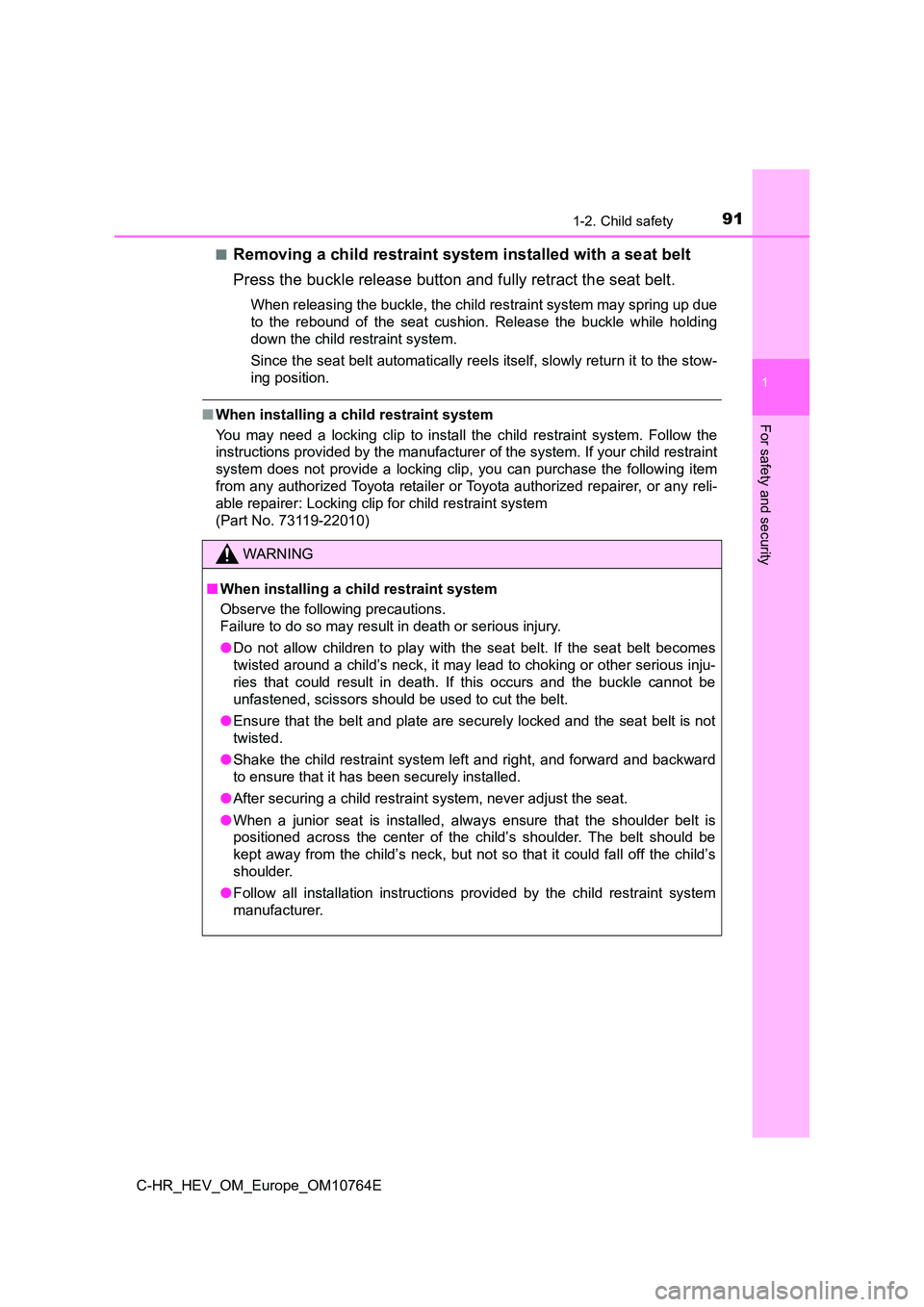
911-2. Child safety
1
For safety and security
C-HR_HEV_OM_Europe_OM10764E
■Removing a child restraint system installed with a seat belt
Press the buckle release button and fully retract the seat belt .
When releasing the buckle, the child restraint system may spring up due
to the rebound of the seat cushion. Release the buckle while ho lding
down the child restraint system.
Since the seat belt automatically reels itself, slowly return i t to the stow-
ing position.
■ When installing a child restraint system
You may need a locking clip to install the child restraint syst em. Follow the
instructions provided by the manufacturer of the system. If you r child restraint
system does not provide a locking clip, you can purchase the fo llowing item
from any authorized Toyota retailer or Toyota authorized repair er, or any reli-
able repairer: Locking clip for child restraint system
(Part No. 73119-22010)
WARNING
■ When installing a child restraint system
Observe the following precautions.
Failure to do so may result in death or serious injury.
● Do not allow children to play with the seat belt. If the seat belt becomes
twisted around a child’s neck, it may lead to choking or other serious inju-
ries that could result in death. If this occurs and the buckle cannot be
unfastened, scissors should be used to cut the belt.
● Ensure that the belt and plate are securely locked and the seat belt is not
twisted.
● Shake the child restraint system left and right, and forward and backward
to ensure that it has been securely installed.
● After securing a child restraint system, never adjust the seat.
● When a junior seat is installed, always ensure that the shoulder belt is
positioned across the center of the child’s shoulder. The belt should be
kept away from the child’s neck, but not so that it could fall off the child’s
shoulder.
● Follow all installation instructions provided by the child restraint system
manufacturer.
Page 94 of 814
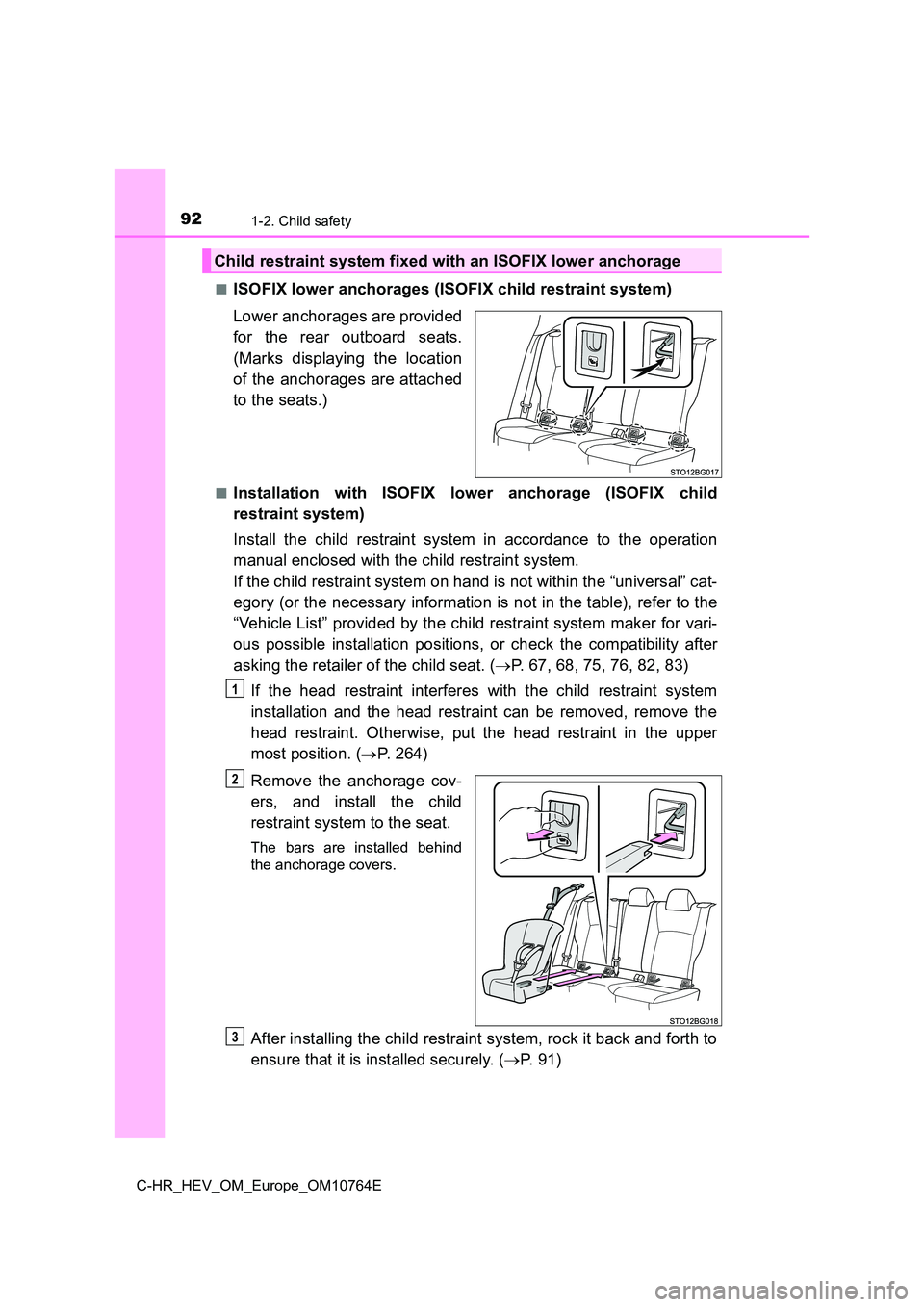
921-2. Child safety
C-HR_HEV_OM_Europe_OM10764E
■ISOFIX lower anchorages (ISOFIX child restraint system)
Lower anchorages are provided
for the rear outboard seats.
(Marks displaying the location
of the anchorages are attached
to the seats.)
■Installation with ISOFIX lower anchorage (ISOFIX child
restraint system)
Install the child restraint system in accordance to the operati on
manual enclosed with the child restraint system.
If the child restraint system on hand is not within the “univer sal” cat-
egory (or the necessary information is not in the table), refer to the
“Vehicle List” provided by the child restraint system maker for vari-
ous possible installation positions, or check the compatibility after
asking the retailer of the child seat. ( P. 67, 68, 75, 76, 82, 83)
If the head restraint interferes with the child restraint syste m
installation and the head restraint can be removed, remove the
head restraint. Otherwise, put the head restraint in the upper
most position. ( P. 264)
Remove the anchorage cov-
ers, and install the child
restraint system to the seat.
The bars are installed behind
the anchorage covers.
After installing the child restraint system, rock it back and f orth to
ensure that it is installed securely. ( P. 9 1 )
Child restraint system fixed with an ISOFIX lower anchorage
1
2
3
Page 95 of 814
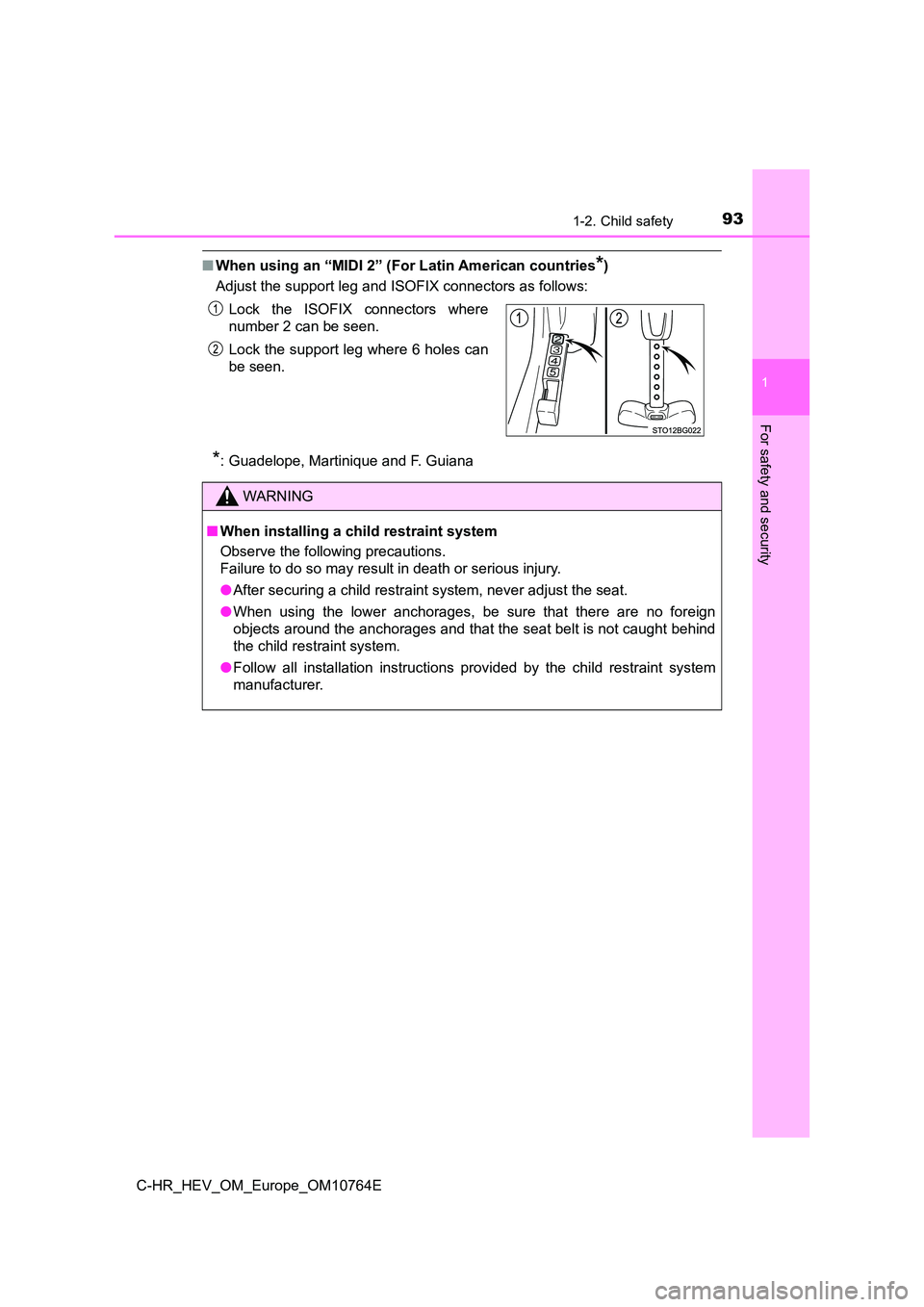
931-2. Child safety
1
For safety and security
C-HR_HEV_OM_Europe_OM10764E
■When using an “MIDI 2” (For Latin American countries*)
Adjust the support leg and ISOFIX connectors as follows:
*: Guadelope, Martinique and F. Guiana
Lock the ISOFIX connectors where
number 2 can be seen.
Lock the support leg where 6 holes can
be seen.
WARNING
■ When installing a child restraint system
Observe the following precautions.
Failure to do so may result in death or serious injury.
● After securing a child restraint system, never adjust the seat.
● When using the lower anchorages, be sure that there are no foreign
objects around the anchorages and that the seat belt is not cau ght behind
the child restraint system.
● Follow all installation instructions provided by the child restraint system
manufacturer.
Page 96 of 814

941-2. Child safety
C-HR_HEV_OM_Europe_OM10764E
■Top tether anchorages
Top tether anchorages are pro-
vided for the outboard rear
seat.
Use top tether anchorages
when fixing the top strap.
■Fixing the top strap to the top tether anchorage
Install the child restraint system in accordance to the operati on
manual enclosed with the child restraint system.
Adjust the head restraint to
the upmost position.
If the head restraint interferes
with the child restraint system or
top strap installation and the
head restraint can be removed,
remove the head restraint.
( P. 264)
Latch the hook onto the top
tether anchorage and tighten
the top strap.
Make sure the top strap is
securely latched. ( P. 91)
When installing the child
restraint system with the head
restraint being raised, be sure to
have the top strap pass under-
neath the head restraint.
Using a top tether anchorage
Top tether anchorages
Top strap
1
Hook
Top strapO
Page 97 of 814

951-2. Child safety
1
For safety and security
C-HR_HEV_OM_Europe_OM10764E
WARNING
■When installing a child restraint system
Observe the following precautions.
Failure to do so may result in death or serious injury.
● Firmly attach the top strap and make sure that the belt is not twisted.
● Do not attach the top strap to anything other than the top tether anchor-
age.
● After securing a child restraint system, never adjust the seat.
● Follow all installation instructions provided by the child restraint system
manufacturer.
● When installing the child restraint system with the head restraint being
raised, after the head restraint has been raised and then the t op tether
anchorage has been fixed, do not lower the head restraint.
Page 98 of 814
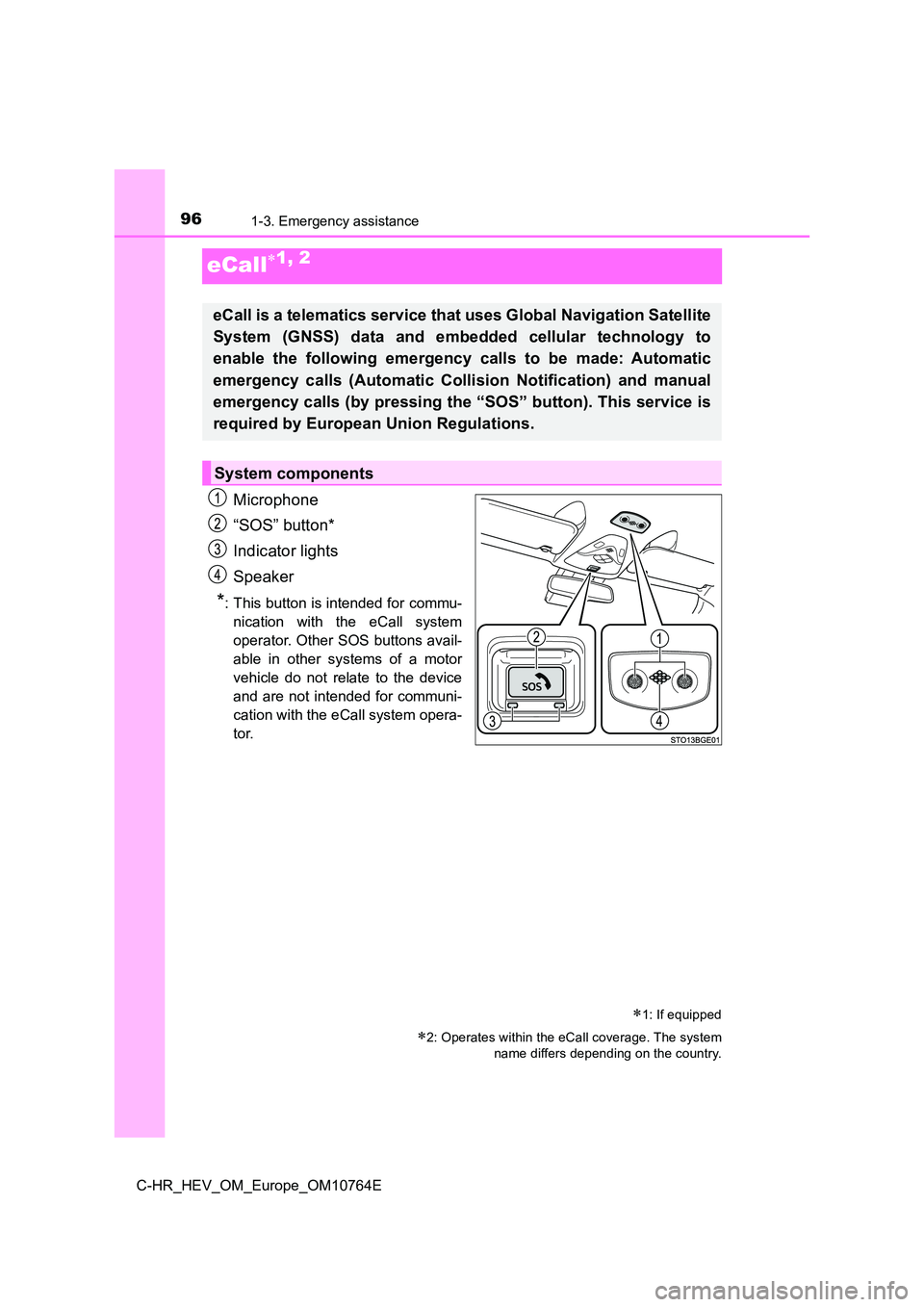
961-3. Emergency assistance
C-HR_HEV_OM_Europe_OM10764E
eCall1, 2
Microphone
“SOS” button*
Indicator lights
Speaker
*: This button is intended for commu-
nication with the eCall system
operator. Other SOS buttons avail-
able in other systems of a motor
vehicle do not relate to the device
and are not intended for communi-
cation with the eCall system opera-
tor.
1: If equipped
2: Operates within the eCall coverage. The system
name differs depending on the country.
eCall is a telematics service that uses Global Navigation Satel lite
System (GNSS) data and embedded cellular technology to
enable the following emergency calls to be made: Automatic
emergency calls (Automatic Collision Notification) and manual
emergency calls (by pressing the “SOS” button). This service is
required by European Union Regulations.
System components
Page 99 of 814
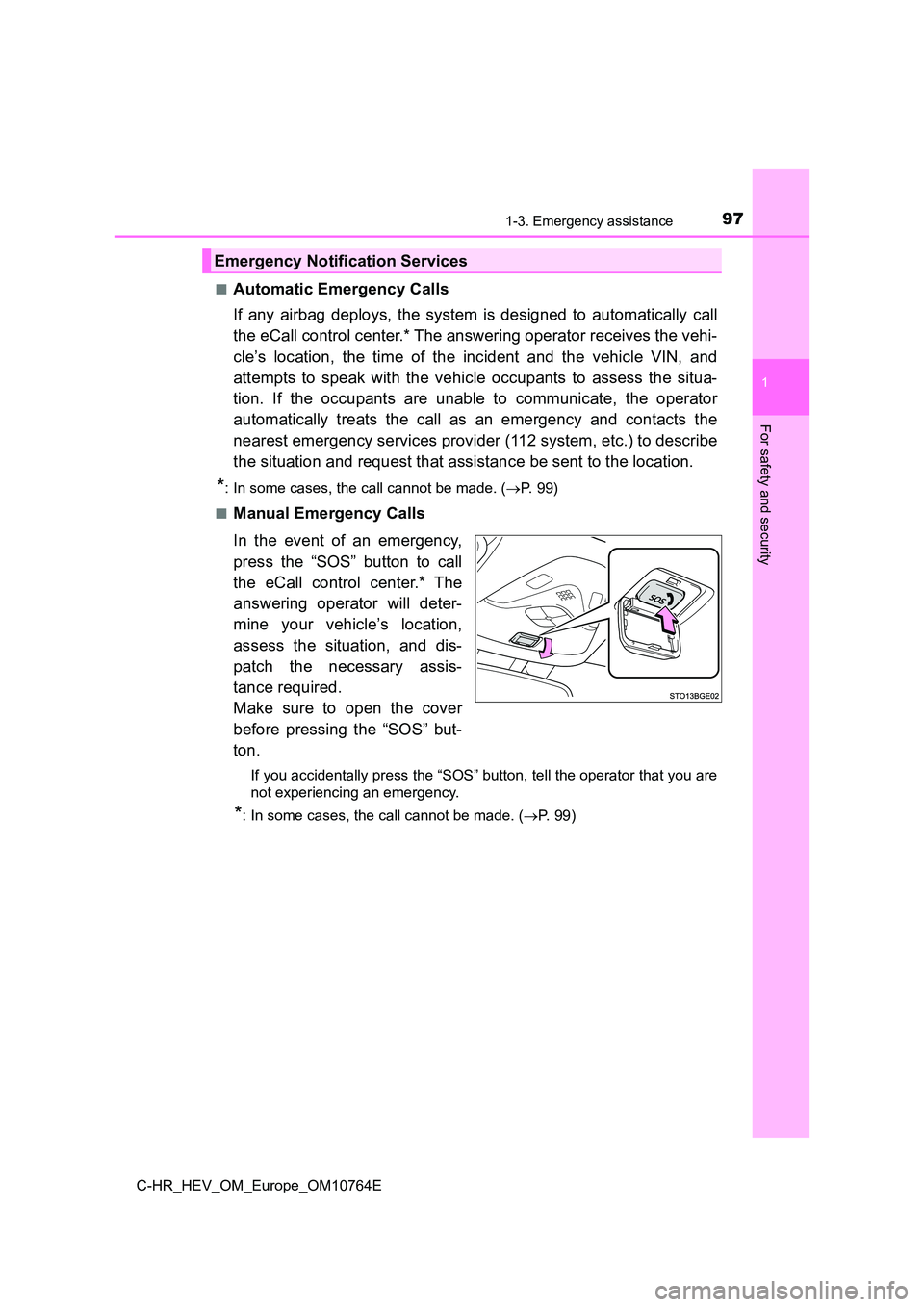
971-3. Emergency assistance
1
For safety and security
C-HR_HEV_OM_Europe_OM10764E
■Automatic Emergency Calls
If any airbag deploys, the system is designed to automatically call
the eCall control center.* The answering operator receives the vehi-
cle’s location, the time of the incident and the vehicle VIN, a nd
attempts to speak with the vehicle occupants to assess the situ a-
tion. If the occupants are unable to communicate, the operator
automatically treats the call as an emergency and contacts the
nearest emergency services provider (112 system, etc.) to descr ibe
the situation and request that assistance be sent to the locati on.
*: In some cases, the call cannot be made. (P. 9 9 )
■Manual Emergency Calls
In the event of an emergency,
press the “SOS” button to call
the eCall control center.* The
answering operator will deter-
mine your vehicle’s location,
assess the situation, and dis-
patch the necessary assis-
tance required.
Make sure to open the cover
before pressing the “SOS” but-
ton.
If you accidentally press the “SOS” button, tell the operator t hat you are
not experiencing an emergency.
*: In some cases, the call cannot be made. ( P. 9 9 )
Emergency Notification Services
Page 100 of 814

981-3. Emergency assistance
C-HR_HEV_OM_Europe_OM10764E
When the power switch is turned to ON, the red indicator light will illu-
minate for 10 seconds and then the green indicator light will i llumi-
nate, indicating that the system is enabled. The indicator ligh ts
indicate the following:
● If the green indicator light illuminates and stays on, the system is
enabled.
● If the green indicator light flashes twice per second, an automatic or
manual Emergency Call is being made.
● If the red indicator light illuminates at any time other than immedi-
ately after the power switch is turned to ON, the system may be
malfunctioning or the backup battery may be depleted.
● If the red indicator light blinks for approximately 30 seconds during
an Emergency Call, the call has been disconnected or the cellul ar
network signal is weak.
■ Free/Open Source Software Information
This product contains Free/Open Source Software (FOSS).
The license information and/or the source code of such FOSS can be found
at the following URL.
https://www.denso.com/global/en/opensource/dcm/toyota/
http://www.opensourceautomotive.com/dcm/toyota/19MC/
Indicator lights